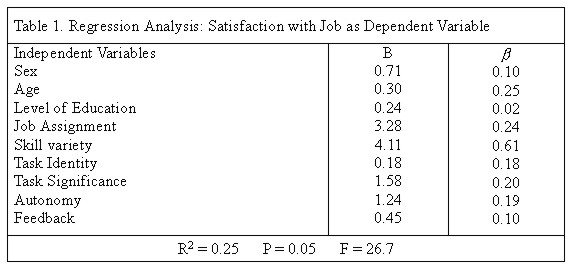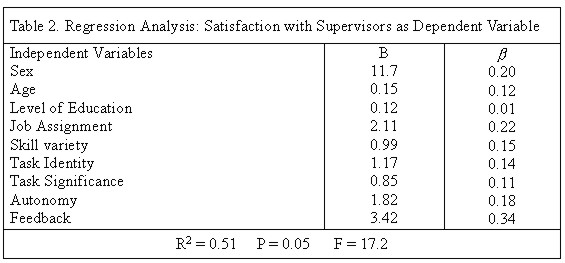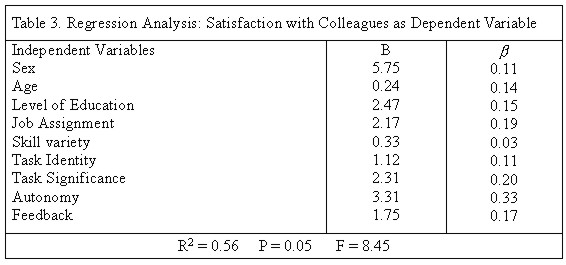THE DETERMINANTS OF PUBLIC OFFICIALS' JOB SATISFACTION - THE CASE OF KOREAN PUBLIC OFFICIALS IN THE CADASTRAL ADMINISTRATIONProf. Yunki KIM, Ph.D., KoreaKey words: Public, Official, Job, Satisfaction, Determinants. INTRODUCTIONJob satisfaction is an emotional reaction to an employee's work situation. This can be defined as an overall impression about one's job in terms of specific aspects of the job (e.g., compensation, autonomy, colleagues) and it can be connected with specific results, such as productivity. Recently, public sector in Korea has undergone drastic organizational restructuring process. With government officials, satisfaction with their jobs may have strong implication for improving the quality of government services. Especially, cadastral worker's satisfaction with his or her job may have a direct impact on the quality of services given to citizen. It is crucial for policy makers to measure the level of cadastral workers' job satisfaction exactly in order to improve the quality of cadastral services given to citizen. Therefore, the primary purpose of this paper is to develop and test multivariate model employing theoretically and conceptually relevant predictors of the cadastral worker's job satisfaction. OVERVIEW OF THEORY AND LITERATUREScientists generally pay attention to two competing sources of workers' job satisfaction. Demographic variablesThe most important demographic variable that receives huge attention in job satisfaction research is sex. A number of empirical studies on job satisfaction have suggested that female workers have lower level of job satisfaction than their male counterparts because male officials dominate most of the public organizations. Another common demographic variable studied is educational level. Most of the researches on the relationship between education level and job satisfaction yield consistent findings. Especially Griffin, Dunbar & McGill (1978) found that workers with higher educational level would tend to be more satisfied with their job than workers with lower educational level. The third commonly identified variable in the research on demographic characteristics is age. Worker's age has been found to have a negative impact on worker's job satisfaction (Buzawa, 1984). This means that younger workers are more satisfied with their jobs than their senior counterparts. The fourth and final variable is the job assignment of a public official. Public officials have many different interests, and these are sometimes satisfied on the job. However, the more public officials find that they can fulfill their interests while on the job, the more satisfied they will be with those jobs. For example, a recent study results showed that university graduates were more satisfied with their jobs when these were consistent with their university majors than when these fell outside their fields of interest (Vandenberg & Lance, 1992). Work environment variablesHerzberg (1959; 1966) developed two-factor theory of job satisfaction: "motivation" and "hygiene". According to Herzberg's theory, if handled properly, hygiene issues cannot motivate workers but can minimize dissatisfaction. Hygiene factors include company policies, supervision, salary, interpersonal relations and working conditions. They are variables related to the worker's environment. By contrast, a worker's job satisfaction was influenced by factors associated with the work itself or by outcomes directly derived from it such as the nature of their jobs, achievement in the work, promotion opportunities, and chances for personal growth and recognition. Because such factors were associated with high levels of job satisfaction, Herzberg referred them as 'motivation factors". Hackman and Oldham (1975) proposed five "core" dimensions for evaluating the immediate work environment constituting the Job Diagnostic Survey UDS. These core dimensions turned out to be associated significantly with job satisfaction and a high sense of workers' motivation. That is, the work environment source consisted of five dimensions, namely those of skill variety, task identity, task significance, autonomy and feedback (Reiner, & Zhao, 1999). The most important characteristic that receives huge attention in Hackman and Oldham's study is the meaningfulness of the work that means to what extent the individual perceives the work as significant and important. Job meaningfulness can be defined as the product of three dimensions: skill variety (activities that challenge skills and abilities); task identity (the extent to which the job requires completion of a "whole", identifiable peace of work); task significance (how substantially the job has impacts on other people's lives. HYPOTHESISDemographic VariablesFour demographic variables are proposed for the job satisfaction model, i.e., sex, educational level, age, and the job assignment. The Sex of Worker The Level of Education The Job Assignment Work Environment VariablesFive work environmental variables are proposed for cadastral workers' job satisfaction model, i.e., skill variety, task identity, task significance, autonomy, and feedback from the job itself. Skill Variety Task Identity Task Significance Autonomy Feedback from the Job Itself METHODOLOGYSamplingThis study is based on the results of interviews of 300 public officials who are in the cadastral administration. Interviews were conducted from September 1, 2000 to November 27, 2000. The systemic sampling with random starts was used to collect the data. The sampling interval was 100 and sampling ratio was 1/100. The questionnaire included four demographic questions. Response to these questions shows that 75% of cadastral workers were male. More than one third of the government employee in our sample have bachelor 's degree. The mean age of study subjects was 39.1 with a range from 27 to 57. ProceduresData were collected through an interview questionnaire administered in subject's office. The interview questionnaire was structured in format and required approximately 15 minutes to administer. MEASURESIndependent variablesThe following independent variables were examined. The sex of worker The level of education The age of public official Type of job assignment The five work environment variables Dependent variablesThe following dependent variables were examined to assess the level of job satisfaction. Satisfaction with Job
To measure the general level of satisfaction with job, scores of each indicator were summed up. Satisfaction with supervisors
To measure the general level of satisfaction with supervisors, scores of each indicator were summed up. Satisfaction with colleagues
To measure the general level of satisfaction with colleagues, scores of each indicator were summed up. ANALYSISTo examine effects of both demographic variables and work environment variables on cadastral workers' job satisfaction, multiple regression analysis was used. And standard regression coefficients were used rather than unstandardized regression coefficients; since most of the measures did mot have natural matrix. RESULTSSatisfaction with JobA test of the full model produced an R-square of 0.59 for satisfaction with job, indicating that over 59% of the variance in satisfaction with job was accounted for by the nine variables in the model (Table 1). Eight of the nine hypothesized relations between independent variables and satisfaction with job were supported. The only one variable that did not conform to hypothesized relations was the level of education. All standardized parameter estimates for the full model are presented in Table 1. In the order of their magnitude, skill variety was the best predictor of public officials’ job satisfaction (b = 0.61). This suggests that performing a variety of tasks is significantly correlated with public officials’ job satisfaction. The age of a worker was the second significant predictor of job satisfaction (b = 0.25). However, this variable did not show the expected negative relation with job satisfaction. The job assignment is the third significant predictor of public officials job satisfaction (b = 0.24). This indicates that public officials in cadastral jobs in the survey reported higher levels of job satisfaction than their counterparts in non-cadastral jobs. Task significance is the fourth important predictor of satisfaction with work (b = 0.20). This result shows that there is statistically significant relationship between the degree of task significance and the level of job satisfaction public officials get from their work.
Autonomy is the fifth significant predictor of job satisfaction (b = 0.19). As expected, autonomy has a significant positive effect on public officials job satisfaction. This means that the higher the degree to which the job provides substantial freedom, independence and discretion of the worker in scheduling the work and determining the procedures to be used in carrying out, the higher the level of the worker’s job satisfaction he or she gets from job. As expected, task identity, sex and feedback have significant positive impacts on the level of public officials job satisfaction. Satisfaction with SupervisorsTable 2 shows that eight of the nine variables are statistically significant predictors of public officials’ satisfaction with their supervisors, accounting for more than half of the variance (R2= 0.51). The only one variable did not conform to hypothesized relations was the level of education. All standardized parameter estimates for the model are presented in Table 2. As expected, feedback from the job itself was the best predictor of public officials’ satisfaction with their supervisors (b = 0.34). This means that the amounts of feedback public officials receive from their supervisors have significant positive impacts on the level of satisfaction with supervisors. The job assignment is the second significant predictor of public officials’ satisfaction with their supervisors (b = 0.22). This indicates that officials in cadastral jobs tend to be more satisfied with their supervisors than their counterparts in non-cadastral jobs. The sex is the third important predictor of satisfaction with supervisors (b = 0.20). As expected, this variable has a strong positive impact on satisfaction with supervisor.
The autonomy variable turned out to be a strong predictor of satisfaction with supervisors (b = 0.18). This results shows that there is a statistically significant relationship between autonomy and satisfaction with supervisors. As expected, such variables as skill variety, task identity, age, and task significance have significant positive influences on public officials satisfaction with their supervisors. Satisfaction with ColleaguesA test of the model produced an R=square of 0.56 for the dependent variable, satisfaction with colleagues, indicating that over 56% of the variance was explained by the nine variables in the model (Table 3).
Eight of the nine hypothesized relations between predictor variables and satisfaction with colleagues were supported. The only one variable that did not conform to hypothesized relations was the skill variety. All beta coefficients for the model are presented in Table 3. As expected, autonomy turned out to be the strongest predictor of public officials’ satisfaction with colleagues (b = 0.33). That is, this variable has a significant positive impact on satisfaction with colleagues. Task significance was the second significant predictor of satisfaction with colleagues (b = 0.20). This means that there is statistically significant relationship between the degree of task significance and the level of satisfaction with colleagues. The job assignment turned out to be a strong predictor of satisfaction with colleagues (b = 0.19). This shows that public workers in cadastral jobs tend to be more satisfied with their colleagues than their counterparts in non-cadastral jobs. Feedback from job itself was the third significant predictor of satisfaction with colleagues (b = 0.17). This implies that the amounts of feedback public officials receive from their colleagues have significant positive effects on the level of satisfaction with colleagues. As expected, the level of education turned out to be a significant predicator of public officials’ satisfaction with their colleagues (b = 0.15). This shows that the level of education have a significant positive impact on the level of satisfaction with colleagues. Such variables as age, task identity, and sex have strong positive impacts on satisfaction with colleagues. DISCUSSION AND CONCLUSIONTo examine effects of both demographic variables and work environment variables on cadastral workers' job satisfaction, multiple regression analysis was used. Study results showed that public officials' overall satisfaction with their job, colleagues, and supervisors was relatively high. Eight of the nine hypothesized relations between independent variables and satisfaction with job were supported. The only one variable that did not conform to hypothesized relations was the level of education. Skill variety turned out to be the best predictor of public officials' job satisfaction. Our study results showed that eight of the nine variables were statistically significant predictors of public officials' satisfaction with their supervisors, accounting for more than half of the variance (R2=0.51). The only one variable did not conform to hypothesized relation was the level of education. As expected, feedback from the job itself was the best predictor of public officials' satisfaction with their supervisor. This means that the amounts of feedback public officials get from their supervisors have significant positive impacts on the level of satisfaction with supervisors. A test of the model produced an R-square of 0.56 for satisfaction with colleagues, indicating that over 56% of the variance was explained by the nine variables in the model. Eight of the nine hypothesized relations between predictor variables and satisfaction with colleagues were supported. The only one variable that did not conform to hypothesized relations was the skill variety. As expected, autonomy turned out to be the strongest predictor of public officials' satisfaction with colleagues. Up to now, we have reviewed factors influencing public officials' job satisfaction. In view of the negative consequences of job dissatisfaction, it makes sense to consider ways of raising satisfaction and preventing job dissatisfaction. Although public officials' job satisfaction might not explain all aspects of their job performances, it is crucial to try to increase satisfaction if for no other reason than to make them happy. The model we have developed and tested here can be used to promote cadastral workers' the job satisfaction in Korea. However, this study, which was based on cross sectional data, has some limitations in predicting public officials' job satisfaction. Therefore, longitudinal studies should be made to increase the predictive power of the model among cadastral workers in Korea. REFERENCESBurk, L. E. (1985). "Relationship of caregiver education to child-oriented attitudes, job satisfaction, and behaviors toward children. Child Care Quarterly, 14, 103-29. Buzawa, E. S. (1984). Determining patrol officer job satisfaction: The role of selected demographic and job-specific attitudes. Criminology, 22, 61-81. Buzawa, E.S., Austin, T & Bannon, J. (1994). The role of selected socio-demographic and job-specific variables in predicting patrol officer job satisfaction: A reexamination ten years later. American Journal of Police, 13, 51- 75. Crewson, PE. (1997). Public-service motivation: Building empirical evidence of incidence and effect. Journal of Public Administration Research and Theory, 4, 499-518. Friesen, D., & Williams, M.J. (1981). Administrator satisfaction. Canadian Administrator, 21, 1-5. Frost, T.F., & Wilson, H.G. (1983). Effects of locus of control and A-B personality type on job satisfaction within the health care field. Psychological Reports, 53, 399-405. Gmelch, W.H., Gates, G., Parkay, F.W., & Torelli, J.A. (1994). The impact of personal, professional, and organizational characteristics on administrator burnout. (ERIC Document Reproduction Service No. ED 373 451) Griffin, G. R., Dunbar, R. & McGill, M. (1978). Factors associated with job satisfaction among police personnel. Journal of Police Science and Administration, 6, 77-85. Griffin, R.W & McMahan, G. C. (1994). Motivation through job design. In J. Greenberg (Ed.) Organizational behavior: The state of the science. Hillsdale, NJ.: L. Erlbaum Associates. Hackman, J. R. & Oldham, G. R. (1975). Development of the job diagnostic survey. Journal of Applied Psychology, 60, 159-170. Herzberg, F. (1976). The managerial choice: To be efficient and to be human. Homewood, IL: Dow Jones-Irwin. Herzberg, F. (1966). Work and the nature of man. Cleveland, OH: World. Herzberg, F., Mausner, B., & Snyderman, B. (1959). The motivation to work. New York: Wiley Jayaratne, S. T (1993). The antecedents, consequences, and correlates of job satisfaction. In RT Golembiewski (Ed.), Handbook of organizational behavior (pp. 111-134). New York: Marcel Dekker, Inc. Kerlinger, F.N. (1986). Foundations of behavioral research (3rd ed.). New York: CBS College. Lange, L. (1983). Women in school administration: Problems and possibilities. High School Journal, 66(2), 83-90. Marshall, C. (1984). From culturally defined to self-defined: Career states of women administrators. Nashville, TN: Vanderbilt University. (ERIC Document Reproduction Service No. ED 272 968) Maslow, A.H. (1970). Motivation and personality (2nd ed.). New York: Harper and Row. O'Reilly, C.A., III, & Roberts, K.H. (1975). Individual differences in personality, position in the organization, and job satisfaction. Organizational Behavior and Human Performance, 14, 144-150. Proffit, A.C. (1990). The relationship between locus of control and job satisfaction of Appalachian principals [CD ROM]. Abstract from ProQuest File: Dissertation Abstracts International, Item 9029346. Reiner, M.D. & Zhao. J. (1999). The Determinants of job satisfaction among United States Airforce Security Police Review of Public Personal Administration, 19, 5-8. Schmidt, L.J. (1992). Women in educational administration: A disappearing construct. Lincoln, NE: Annual conference of women in administration. (ERIC Document Reproduction Service No. ED 350 707) Sharratt, G., & Derrington, M.L. (1993). Female superintendents' attributes that attract and barriers that discourage their successful applications. (ERIC Document Reproduction Service No. ED 362 941) Vandenberg, R. J., &Lance, C. E. (1992). Examining the causal order of job satisfaction and organizational commitment. Journal of Management, 18, 153-167. Vroom, V (1964). Work and motivation. New York: Wiley. Weber, M. (1977). In H. Gerth & C. Mills (Eds.) From Max Weber: Essays in Sociology. Trans., 3rd ed. New York: Oxford University. BIOGRAPHICAL NOTEYun-Ki Kim is Professor of Urban Administration and GIS at the Department of Land Management, Chongju University, Chongju, Korea, where he has taught since 1985. Formerly, he was a Visting Fulbright Schollor at Columbia University (91-92). He was a Fulbright Research Awards Grantee too (91). Currently, he serves as a member of board of directors of three Korean academic associations, including Korean Association of Cadastral Information. He served as chairman of Chongju University's Department of Land Management during 1996-1999. He is the author of Internet and Land Information (Chongju University Press, 1999). CONTACTProfessor Yunki Kim, Ph.D. 17 April 2001 This page is maintained by the FIG Office. Last revised on 15-03-16. |



